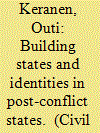| Srl | Item |
| 1 |
ID:
133578


|
|
|
|
|
| Publication |
2014.
|
| Summary/Abstract |
An integral part of state formation processes is identity-building: 'making one out of many' as Walzer puts it. This is also true in terms of contemporary, internationally led statebuilding projects. This dimension of international statebuilding is important, as fundamental questions pertaining to belonging are as important to successful post-conflict process as institutional arrangements; in fact, assumptions about identities and group boundaries guide the technical decisions on institutional and governance structures. The central aim of this paper is to reflect upon identity-construction as a part of post-conflict statebuilding through exploring how historical and more recently invented symbols are deployed to construct a specific sense of belonging. The analysis finds a multiplicity of identity-building projects that advance different visions of community and belonging. The outcome is politicised and contentious visual, everyday landscape that legitimises competing local statebuilding projects (grounded in the distinctions between Bosnian peoples), while undermining peacebuilding and reconciliation. Yet, rather than indicating a primordial antagonisms or incompatible 'liberal' and 'local' norms, the conflicts over symbols (and ultimately, identities) between international and local agents are indicative of wider disagreements over how the Bosnian state ought to be organised and are fuelled by the institutional structures of the country and the weaknesses in the international statebuilding
|
|
|
|
|
|
|
|
|
|
|
|
|
|
|
|
| 2 |
ID:
150580


|
|
|
|
|
| Summary/Abstract |
While significant obstacles to the realization of the Responsibility to Protect in practice remain, it has nonetheless made considerable progress in transforming from an idea to an emerging norm. At the same time, however, its sister component, the Responsibility to Rebuild has elicited less scholarly and policy attention. The lack of attention to rebuilding responsibilities has been made all the more urgent by the violent aftermath of the first protection intervention in Libya in 2011. Against this backdrop, the article examines the way in which the Responsibility to Rebuild is understood and operationalized, with reference to Libya and Côte d'Ivoire, theaters of two recent protection interventions. The conceptual evolution of the Responsibility to Rebuild reveals a distinct shift toward a more statist understanding of the rebuilding phase; what was initially considered a part of the wider international protection responsibility has come to be viewed as a domestic responsibility. This recalibration of the responsibility to rebuild stems from the concept's association with the reactive element of R2P as well as from the changes in the wider normative environment. The more statist understanding of rebuilding responsibilities has manifested itself not only in the emphasis on domestic ownership of the rebuilding process in the wake of protection interventions, but also in the reconceptualization of the wider international Responsibility to Rebuild as a narrower responsibility to assist in building the capacity of the state subjected to protection intervention. This has been problematic in policy terms as the attempt to build capacity through the standard state-building measures has resulted at best in negative peace and at worst in armed violence.
|
|
|
|
|
|
|
|
|
|
|
|
|
|
|
|